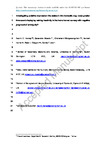Investigating putative depression-like states in the domestic dog: does greater time spent displaying waking inactivity in the home kennel co-vary with negative judgment of ambiguity?
| dc.contributor.author | Harvey, ND | |
| dc.contributor.author | Moesta, A | |
| dc.contributor.author | Wongsaengchan, C | |
| dc.contributor.author | Harris, H | |
| dc.contributor.author | Craigon, PJ | |
| dc.contributor.author | ESTEBAN , ARRIBAS REYES | |
| dc.date.accessioned | 2020-05-19T14:42:53Z | |
| dc.date.available | 2020-05-19T14:42:53Z | |
| dc.date.issued | 2020-05-19 | |
| dc.identifier.issn | 0168-1591 | |
| dc.identifier.issn | 1872-9045 | |
| dc.identifier.other | 105025 | |
| dc.identifier.uri | http://hdl.handle.net/10026.1/15689 | |
| dc.description | 12 months embargo applies | |
| dc.description.abstract |
Exposure to chronic stressors and/or traumatic events can trigger depression-like forms of waking inactivity in non-human species (mice, horses, primates) as well as clinical depression in humans. This study aimed to test the hypothesis that elevated levels of waking inactivity in the home environment, in tandem with exposure to chronic stress and/or traumatic events, could reflect a depression-like condition in the domestic dog. We tested this hypothesis in shelter dogs by investigating the association between greater time spent inactive ‘awake but motionless’ (ABM) in the home-pen and a core symptom of human clinical depression; low mood, using negative judgment of ambiguity as a proxy. Subjects were 20 dogs from across three shelters (10F:10 M, aged 3.8 years ± SD 2.0; 45% seized as part of legal cases, 30% found as strays, 25% relinquished to the shelters). Time spent ABM was determined from 6 h of video per dog (one daily 2-h period recorded across three consecutive days, following a day and time period blocked design). To measure judgment of ambiguity, dogs were trained in a location discrimination task that a bowl either contained food (positive location) or was empty (negative location). Dogs were tested with one negative, one positive, and one ambiguous (equidistant to the two training positions) trial. Negative judgment of ambiguity manifests as longer latencies to reach the ambiguous bowl. We created a positive expectancy score by adjusting the latency in the ambiguous trial to the latency to approach the negative and positive locations (higher scores indicating bias towards expecting more positive outcomes). Time spent ABM was compared against positive expectancy scores using a multivariable GLM. Dogs were ABM for a median of 2.8% of the scans (Q1: 0.75%, Q3: 4.75), with clear inter-individual variation (0–20.4%). In the cognitive judgment bias, stray dogs reached the learning criterion faster than those of other origins (ANOVA: F19 = 4.03, p = 0.037; Kaplan-Meier survival analyses, Chi22 = 7.88, p = 0.019). During the test trials, all latencies statistically differed from each other (Negative > Ambiguous > Positive, Friedman test Chi-square(2) = 33.90, p = <0.001). Cognitive expectancy scores however exhibited minimal variation and an exaggerated right-skew distribution, showing a strong bias towards expecting a positive outcome at the ambiguous location in most of the dogs, and showed no association (p> 0.05) with time spent ABM, therefore the hypothesis was not supported. We discuss reasons for observing such general ‘optimistic’ tendencies in this study, as well as further research directions. | |
| dc.format.extent | 105025-105025 | |
| dc.language | en | |
| dc.language.iso | en | |
| dc.publisher | Elsevier BV | |
| dc.subject | Shelter dogs | |
| dc.subject | Affective state | |
| dc.subject | Depression-like state | |
| dc.subject | Waking inactivity | |
| dc.subject | Cognitive judgment bias | |
| dc.subject | Stray dogs | |
| dc.title | Investigating putative depression-like states in the domestic dog: does greater time spent displaying waking inactivity in the home kennel co-vary with negative judgment of ambiguity? | |
| dc.type | journal-article | |
| plymouth.author-url | https://www.webofscience.com/api/gateway?GWVersion=2&SrcApp=PARTNER_APP&SrcAuth=LinksAMR&KeyUT=WOS:000571225500010&DestLinkType=FullRecord&DestApp=ALL_WOS&UsrCustomerID=11bb513d99f797142bcfeffcc58ea008 | |
| plymouth.volume | 230 | |
| plymouth.publication-status | Published | |
| plymouth.journal | Applied Animal Behaviour Science | |
| dc.identifier.doi | 10.1016/j.applanim.2020.105025 | |
| plymouth.organisational-group | /Plymouth | |
| plymouth.organisational-group | /Plymouth/Faculty of Science and Engineering | |
| plymouth.organisational-group | /Plymouth/REF 2021 Researchers by UoA | |
| plymouth.organisational-group | /Plymouth/REF 2021 Researchers by UoA/UoA04 Psychology, Psychiatry and Neuroscience | |
| dcterms.dateAccepted | 2020-05-03 | |
| dc.rights.embargodate | 2021-5-19 | |
| dc.identifier.eissn | 1872-9045 | |
| dc.rights.embargoperiod | Not known | |
| rioxxterms.versionofrecord | 10.1016/j.applanim.2020.105025 | |
| rioxxterms.licenseref.uri | http://www.rioxx.net/licenses/all-rights-reserved | |
| rioxxterms.licenseref.startdate | 2020-05-19 | |
| rioxxterms.type | Journal Article/Review |


